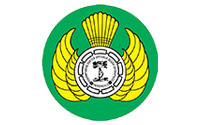Type III Osteogenesis Imperfecta with Severe Limb Deformities: A Report with Review of The Literature
Downloads
Background: Type III osteogenesis imperfecta (OI) is very rare. In this article, we describe the clinical features and management of a case of type III osteogenesis imperfecta with a review of the literature.
Case Report: A 5 – year - old girl presented with deformities of the bilateral lower and upper limbs. Posterior bowing of both humerus, cubitus varus deformity of both elbows, shepherd crook deformities of the femur, and anterolateral bowing of both legs were observed. She was unable to walk. Her face was triangular, and she had a kyphoscoliotic deformity of the spine. Radiographs showed osteopenia and multiple fractures at different stages of healing. The clinical and radiological findings were consistent with those of type III OI. She was treated by deformity correction of the right femur and tibia using the Sofield technique.
Discussion: OI is a disorder caused by a mutation in type 1 collagen. It is characterized by increased bone fragility, dentigerous imperfecta, and generalized ligamentous laxity. There are 18 types of OI. We describe a case of type 3 OI in which the child developed deformity of the spine and limb at a later age without involvement of the sclera. Lower limb deformities were corrected using the Sofield technique of multiple osteotomies and intramedullary nailing. The implants were removed once the osteotomies were united. After implant removal, anterolateral bowing of the tibiae recurred.
Conclusions: Long bone deformities can be managed using the Sofield technique. Long-term follow-up is essential for the early detection and correction of recurrence.
Rowe DW. Osteogenesis imperfecta. In: GeneReviews®. Seattle (WA): University of Washington, Seattle; 1993-2024. 2020:1489-505.
Sam JE, Dharmalingam M. Osteogenesis imperfecta. Indian J Endocr Metab. 2017;21(6):903-8.
Forlino A, Marini JC. Osteogenesis imperfecta. Lancet. 2016;387(10028):1657-71.
Palomo T, Vilaça T, Lazaretti-Castro M. Osteogenesis imperfecta. Curr Opin Endocrinol Diabetes Obes. 2017;24(6):381-8.
Zaripova AR, Khusainova RI. Modern classification and molecular-genetic aspects of osteogenesis imperfecta. Vestn Volgogr Gos Med Univ. 2020;24(2):219-27.
Nijhuis WH, Eastwood DM, Allgrove J, Hvid I, Weinans HH, Bank RA, et al. Current concepts in osteogenesis imperfecta: bone structure, biomechanics and medical management. J Child Orthop. 2019;13(1):1-11.
Morello R. Osteogenesis imperfecta and therapeutics. Matrix Biol. 2018;71-72:294-312.
Harsevoort AGJ, Gooijer K, van Dijk FS, van der Grijn DAFM, Franken AAM, Dommisse AMV, et al. Fatigue in adults with Osteogenesis Imperfecta. BMC Musculoskelet Disord. 2020;21(1):6.
Veilleux LN, Darsaklis VB, Montpetit K, Glorieux FH, Rauch F. Muscle function in osteogenesis imperfecta type IV. Calcif Tissue Int. 2017;101(4):362-70.
Arantes C, Sica I, Bezerra M, Amaral C, Bellato C, Logar G. Osteogenesis imperfecta type III: oral, craniofacial characteristics and atypical radiographic findings oral. J Clin Exp Dent. 2021;13(11):e1053-6.
Gazzotti S, Sassi R, Aparisi Gómez MP, Moroni A, Brizola E, Miceli M, et al. Imaging in osteogenesis imperfecta: where we are and where we are going. Eur J Med Genet. 2024;68:104926.
Marini JC, Forlino A, Bächinger HP, Bishop NJ, Byers PH, Paepe A, et al. Osteogenesis imperfecta. Nat Rev Dis Primers. 2017;3:17052.
Ralston SH, Gaston MS. Management of Osteogenesis Imperfecta. Front Endocrinol (Lausanne). 2020;10:924.
Mueller B, Engelbert R, Baratta-Ziska F, Bartels B, Blanc N, Brizola E, et al. Consensus statement on physical rehabilitation in children and adolescents with osteogenesis imperfecta. Orphanet J Rare Dis. 2018;13(1):158.
Rothschild L, Goeller JK, Voronov P, Barabanova A, Smith P, et al. Anesthesia in children with osteogenesis imperfecta: retrospective chart review of 83 patients and 205 anesthetics over 7 years. Paediatr Anaesth. 2018 Nov;28(11):1050-8.
Franzone JM, Shah SA, Wallace MJ, Kruse RW, et al. Osteogenesis imperfecta: a pediatric orthopedic perspective. Orthop Clin North Am. 2019 Apr;50(2):193-209.
Mahendra IGBS, Purnaning D. Osteogenesis imperfecta: case report and literature review. Jurnal Penelitian Pendidikan IPA. 2024;10(11):9106-13.
Vorster A, Beighton P, Chetty M, Ganie Y, Henderson B, Honey E, et al. Osteogenesis imperfecta type 3 in South Africa: causative mutations in FKBP10. S Afr Med J. 2017;107(5):457-62.
Kurashina T, Fukui T, Oe K, Sawauchi K, Kuroda R, Takahiro T. Management of infected non-union following femoral shaft fracture in a patient with Klippel-Trenaunay syndrome: a case report. J Orthop Case Rep. 2022;12(7):38-41.
Vankevičienė K, Matulevičienė A, Mazgelytė E, Paliulytė V, Vankevičienė R, Ramašauskaitė D. A sporadic case of COL1A1 osteogenesis imperfecta: from prenatal diagnosis to outcomes in infancy—case report and literature review. Genes (Basel). 2023;14(11):2062.
Kumar A, Saikia UK, Bhuyan AK, Baro A, Prasad SG. Zoledronic acid treatment in infants and toddlers with osteogenesis imperfecta is safe and effective: a tertiary care centre experience. Indian J Endocr Metab. 2023;27(3):255-9.
Letocha AD, Cintas HL, Troendle JF, Reynolds JC, Cann CE, Chernoff EJ, et al. Controlled trial of pamidronate in children with types III and IV osteogenesis imperfecta confirms vertebral gains but not short-term functional improvement. J Bone Miner Res. 2005 Jun;20(6):977-86.
Copyright (c) 2025 Journal Orthopaedi and Traumatology Surabaya

This work is licensed under a Creative Commons Attribution-NonCommercial-ShareAlike 4.0 International License.
- The author acknowledges that the copyright of the article is transferred to the Journal of Orthopaedi and Traumatology Surabaya (JOINTS), whilst the author retains the moral right to the publication.
- The legal formal aspect of journal publication accessibility refers to Creative Commons Attribution-Non Commercial-Share Alike 4.0 International License (CC BY-NC-SA).
- All published manuscripts, whether in print or electronic form, are open access for educational, research, library purposes, and non-commercial uses. In addition to the aims mentioned above, the editorial board is not liable for any potential violations of copyright laws.
- The form to submit the manuscript's authenticity and copyright statement can be downloaded here.
Journal of Orthopaedi and Traumatology Surabaya (JOINTS) is licensed under a Creative Commons Attribution-Non Commercial-Share Alike 4.0 International License.



























 Journal Orthopaedi and Traumatology Surabaya (JOINTS) (
Journal Orthopaedi and Traumatology Surabaya (JOINTS) (